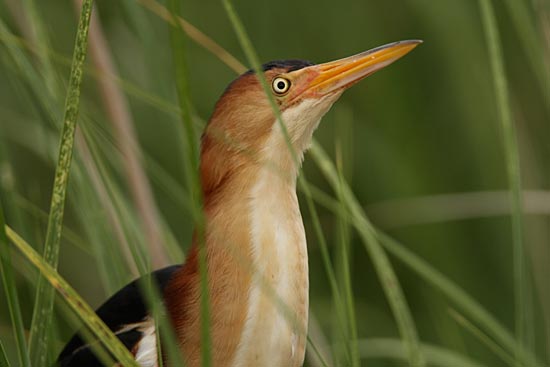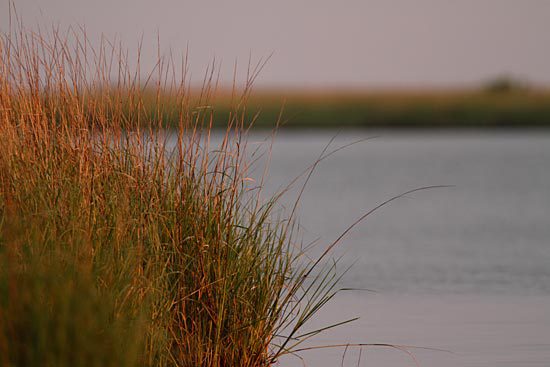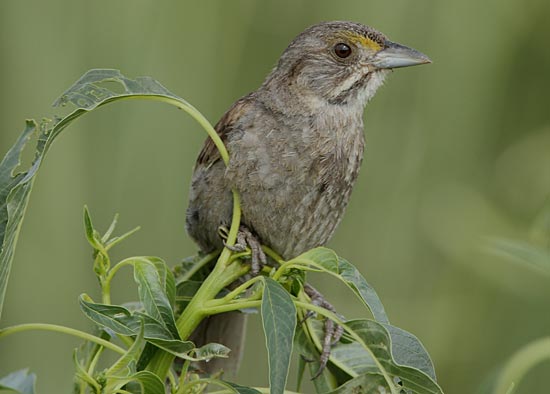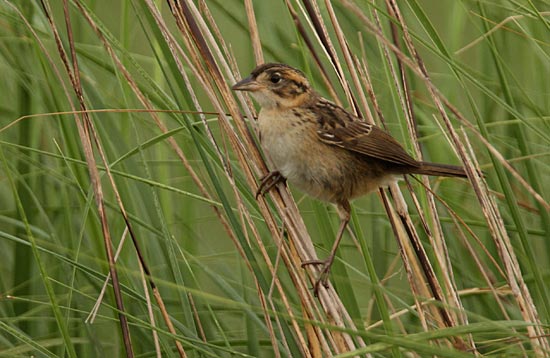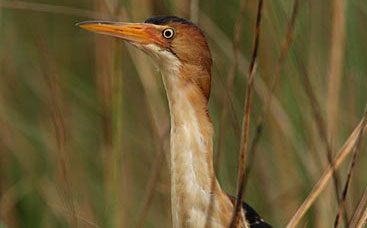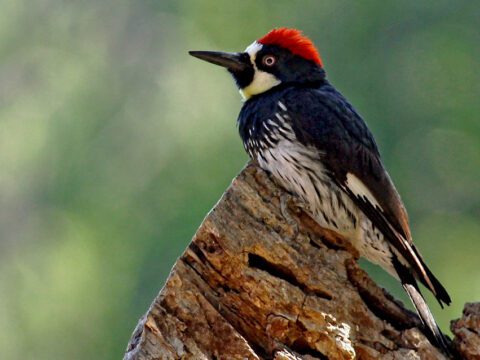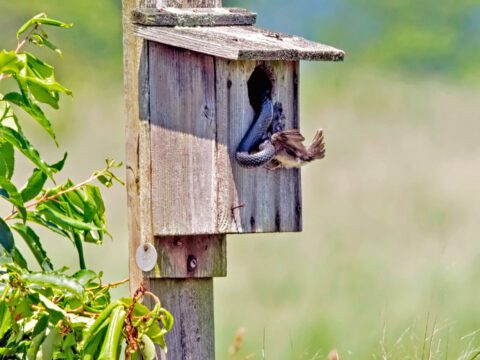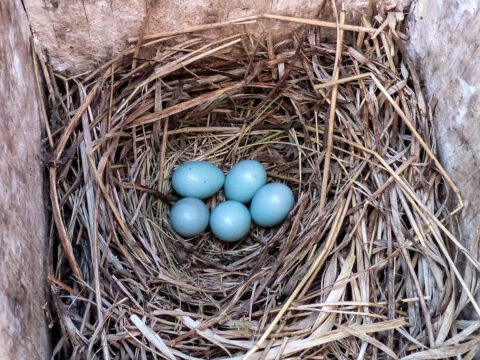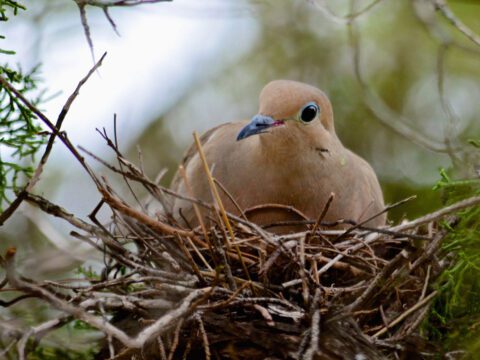Louisiana Report: In the Saltmarsh (slideshow)
Text by Hugh Powell. Images by Benjamin Clock.
June 20, 2010
Least Bittern in saltmarsh west of West Point a la Hache, Louisiana 
Birds of the saltmarsh make their living squeezed into a few feet between water and sky 
Seaside Sparrows specialize in the narrow confines of saltmarsh grass 
We found a few young-of-the-year Seaside Sparrows already fledged 
An assertive Least Bittern made its way through the grasses to eye us 
The sun set on us as we enjoyed this as-yet oil-free marsh
Yesterday I flew to southern Louisiana to join our video team, Ben Clock and Larry Arbanas. They’ve been here for nearly three weeks already, documenting how birds are faring during the Gulf oil catastrophe.
Ben and Larry let me in easy, with an oil-free day filming the enormous diversity of waterbirds around Venice, Louisiana, and in the bayous and channels northeast of Barataria Bay. (We want to film birds in unspoiled settings, not just oil-covered birds, as a way to illustrate what is at stake here and to be able to compare with future visits.)
For our trip through the bay waters, we hopped onto a 20-foot motorboat captained by David Iverson, a garrulous 63-year-old ex-oil-rig machinist and local fishing guide. He’s tall, looks rather like a white-haired Bill Murray, and is never short of tall tales and keen observations about the Delta waters, delivered in a strong Southern accent with a touch of Cajun roll. He met us at the dock, wearing white pants and a long-sleeved white shirt, driving a white Suburban (he likes the color green better, but favors white as a defense against the heat). His hat was white, too, except for under the brim, which he’d spray-painted black to fight glare.
The saltmarsh here is an immense but tattered lacework of islands, bayous, and strands of green-and-russet saltmarsh, all criss-crossed with channels cut for gas pipelines. We roared through it, Iverson gunning his 250-hp engine, until Larry noticed a small, buff-and-black heron beating alongside us. It was a Least Bittern, about the size of a cantaloupe, veering away from our channel and toward a low line of saltmarsh grass. Iverson wheeled the boat around to go back, and an Eastern Kingbird watched in bewilderment. “He looked at us just like a hog looking at a wristwatch,” Iverson said, and nosed the boat up toward the bank.
Saltmarsh birds are mostly auditory beings: you can’t see more than a few inches in, so you either pray that they’ll perch on a grass-top, or try to be satisfied with just hearing them. But less than 10 minutes after we stopped, we spotted a Least Bittern perched in the grass, preening and occasionally giving its quiet coughing call in response to two others calling in the distance.
All around us was the quiet tick-tick-buzzing of another saltmarsh specialty, the Seaside Sparrow. There were dozens of these odd sparrows here: very dark gray, with a little rag of a tail, long body, flat head, and a long, outsized beak that looks like a sunflower seed jutting out from its face. The birds seem skinnier than most sparrows, as if from continually squeezing between grasses. The throat bears a narrrow white rectangle that flashes when the bird looks right at you, and a tinge of yellow over the eye, almost hidden in the dark gray of the face. They fly weakly, fluttering their wings and perilously losing altitude when they cross open water.
Both Seaside Sparrows and Least Bitterns are characteristic birds of this saltmarsh. Their world is a constricted zone of green and brown stems a couple of feet high. Beneath them is salt (or brackish) water that rises and falls with the tide; nothing above them but sky and thunderclouds. Nests must be carefully placed far enough in the grass for shade but above the height of the highest tides. A couple of young-of-the-year Seaside Sparrows, with buffy faces and pale underparts, chipped for their parents from beside our boat.
Ben set down his camera and took out a parabolic microphone to capture the sounds of the saltmarsh. He put on headphones to monitor the levels but shook his head. The sensitive microphone was picking up our cell phones sending data packets to the towers in the distance. After we turned them off, he could still hear freighters moving up the Mississippi, about three miles away.
The raspy clatter of clapper rails was all over the marsh, along with the tink-a-tinck introduction to the Seaside Sparrow’s call. The buzzy end to the call is hard to hear at any distance. Beyond that, there was just the occasional Laughing Gull and the constant slapping of leaping mullet against the water.
Now a Least Bittern came creeping through the grasses to investigate us. I saw its yellow eyes first, through the dried stems, staring down its yellow bill. It moved confidently through the tangled vegetation, pushing its chest forward and then sweeping its long legs and bunched feet, keeping its long bill free of the grass. I imagined trying to walk through a cornfield wearing two grappling hooks and a sword.
Though these birds fly fast and level (we had clocked the first one at about 30 mph) they cover short distances with something between a flap and a hop. This one trailed its long legs as it flapped over the water, clutching for the grass, knees almost knocking.
As the bird came closer we could see how small this smallest of American herons really was. Not much more than grackle sized, but beautiful: straw-colored underparts deepening to buffy on the sides and rich russet on the back of the neck, with a black cap and back. It hunched in typical heron posture, a compact ellipse and a single sharp line for the bill.
The sun was setting and turning the saltmarsh a deep tan and the water and sky a cornflower blue. In the distant trees, the screeling sound of cicadas ratcheted up another notch. The last new bird of the day was a Roseate Spoonbill flying high against the clouds—two crescents of pink fading into blue.
In the morning we’re going farther south, where the team found oil last week. But for this evening, we were content to let the still-thriving Delta envelop us.

All About Birds
is a free resource
Available for everyone,
funded by donors like you
American Kestrel by Blair Dudeck / Macaulay Library
